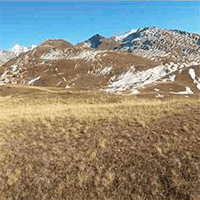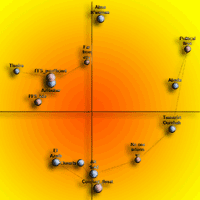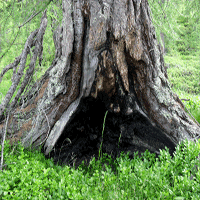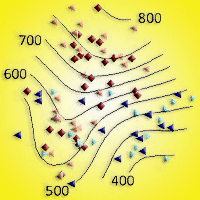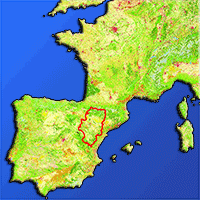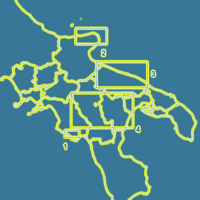Northern European heathlands and moorlands dominated by Calluna vulgaris are internationally recognized for their conservation importance while also supporting traditional, low-intensity agriculture and game hunting. Managed burning plays an important role in maintaining these ecosystems but climate and land-use changes, including planned or unplanned transitions to forest and woodland, are now resulting in concerns about increasing wildfire frequency, intensity and severity. In combination with rapidly-changing regulations surrounding managed burning, this has highlighted the need to understand current and potential future fuel structures to effectively model fire behaviour and develop evidence-based regulations surrounding managed burning. We developed standardized heathland fuel descriptions and modeled associated fire behaviour for heathlands in the UK (England, Scotland) and Norway. Utilizing existing fuel and biomass data, we used cluster analysis to identify five distinct fuel models and assessed how they were represented across C. vulgaris life-stages, geographic locations and EUNIS habitat-types. We validated their independence by examining predicted fire rates of spread based across three representative fire weather scenarios. Fire rates of spread differed between C. vulgaris life stages, regardless of EUNIS community or country. Mature stage and taller building stage fuels produced the highest fire rates of spread and early, shorter building and pioneer stage fuels produced the lowest. Moss and litter fuel loads proved to be important determinants of fire rate of spread in a high-risk fire weather scenario. An understanding of links between fuel types and potential fire behaviour can be used to inform management and policy decisions. To aid in this, we used classification tree analysis to link fuel types to easily-observable characteristics. This will facilitate pairing the fuel models with fire behaviour prediction software to make evidence-based assessments of management fire safety and wildfire risk.
Keywords
, , , , , , ,
Citation
Minsavage-Davis CD, Davies GM, Haugum SV, Thorvaldsen P, Guri Velle L, Vandvik V (2024). Development and evaluation of generalized fuel models for predicting fire behaviour in northern European heathlands. iForest 17: 109-119. - doi: 10.3832/ifor4394-017
Academic Editor
Davide Ascoli
Paper history
Received: May 30, 2023
Accepted: Apr 16, 2024
First online: Apr 30, 2024
Publication Date: Apr 30, 2024
Publication Time: 0.47 months
© SISEF - The Italian Society of Silviculture and Forest Ecology 2024
Open Access
This article is distributed under the terms of the Creative Commons Attribution-Non Commercial 4.0 International (https://creativecommons.org/licenses/by-nc/4.0/), which permits unrestricted use, distribution, and reproduction in any medium, provided you give appropriate credit to the original author(s) and the source, provide a link to the Creative Commons license, and indicate if changes were made.

Breakdown by View Type
(Waiting for server response...)
Article Usage
Total Article Views: 507
(from publication date up to now)
Breakdown by View Type
HTML Page Views: 67
Abstract Page Views: 253
PDF Downloads: 180
Citation/Reference Downloads: 0
XML Downloads: 7
Web Metrics
Days since publication: 17
Overall contacts: 507
Avg. contacts per week: 208.76
Article Citations
Article citations are based on data periodically collected from the Clarivate Web of Science web site
(last update: Feb 2023)
(No citations were found up to date. Please come back later)
Publication Metrics
by Dimensions ©
Articles citing this article
List of the papers citing this article based on CrossRef Cited-by.
(1)
Anderson MJ (2017)Permutational Multivariate Analysis of Variance (PERMANOVA). In: “Wiley StatsRef: Statistics Reference Online” (Balakrishnan N, Colton T, Everitt B, Piegorsch W, Ruggeri F, Teugels JL eds). John Wiley & Sons, Ltd., Hoboken, NJ, USA, pp. 15.
CrossRef |
Gscholar
(2)
Andrews PL (2014)Current status and future needs of the BehavePlus Fire Modeling System. International Journal of Wildland Fire 23: 21-33.
CrossRef |
Gscholar
(3)
Andrews PL (2018)The Rothermel surface fire spread model and associated developments: a comprehensive explanation. General Technical Report RMRS-GTR-371, USDA Forest Service, Rocky Mountain Research Station, Fort Collins, CO, USA.
Online |
Gscholar
(4)
Arnell NW, Freeman A, Gazzard R (2021)The effect of climate change on indicators of fire danger in the UK. Environmental Research Letters 16: 044027.
CrossRef |
Gscholar
(5)
Ascoli D, Beghin R, Ceccato R, Gorlier A, Lombardi G, Lonati M, Marzano R, Bovio G, Cavallero A (2009)Developing an adaptive management approach to prescribed burning: a long-term heathland conservation experiment in north-west Italy. International Journal of Wildland Fire 18: 727-735.
CrossRef |
Gscholar
(6)
Bjerke JW, Treharne R, Vikhamar-Schuler D, Karlsen SR, Ravolainen V, Bokhorst S, Phoenix GK, Bochenek Z, Tømmervik H (2017)Understanding the drivers of extensive plant damage in boreal and Arctic ecosystems: insights from field surveys in the aftermath of damage. Science of the Total Environment 599-600: 1965-1976.
CrossRef |
Gscholar
(7)
Britton AJ, Fisher JM (2006)Interactive effects of nitrogen deposition, fire and grazing on diversity and composition of low-alpine prostrate
Calluna vulgaris heathland. Journal of Applied Ecology 44: 125-135.
CrossRef |
Gscholar
(8)
Casals P, Gabriel E, De Cáceres M, Ríos AI, Castro X (2023)Composition and structure of Mediterranean shrublands for fuel characterization. Annals of Forest Science 80 (1): 77.
CrossRef |
Gscholar
(9)
Cruz MG, Alexander ME, Sullivan AL (2017)Mantras of wildland fire behaviour modelling: facts or fallacies? International Journal of Wildland Fire 26: 973-981.
CrossRef |
Gscholar
(10)
Cruz MG, Gould JS, Hollis JJ, McCaw WL (2018a)A hierarchical classification of wildland fire fuels for Australian vegetation types. Fire 1: 13.
CrossRef |
Gscholar
(11)
Cruz MG, Alexander ME, Sullivan AL, Gould JS, Kilinc M (2018b)Assessing improvements in models used to operationally predict wildland fire rate of spread. Environmental Modelling and Software 105: 54-63.
CrossRef |
Gscholar
(12)
Davies CE, Moss D, Hill MO (2004)EUNIS habitat classification revised 2004. European Environment Agency, European Topic Centre on Nature Protection and Biodiversity, Copenhagen, Denmark, pp. 310.
Online |
Gscholar
(13)
Davies GM, Legg CJ, Hamilton A, Smith AA (2008)Using visual obstruction to estimate heathland fuel load and structure. International Journal of Wildland Fire 17: 380-389.
CrossRef |
Gscholar
(14)
Davies GM, Legg CJ, Smith AA, MacDonald AJ (2009)Rate of spread of fires in
Calluna vulgaris-dominated moorlands. Journal of Applied Ecology 46: 1054-1063.
CrossRef |
Gscholar
(15)
Davies GM, Legg CJ, O’Hara R, MacDonald AJ, Smith AA (2010)Winter desiccation and rapid changes in the live fuel moisture content of
Calluna vulgaris. Plant Ecology and Diversity 3: 289-299.
CrossRef |
Gscholar
(16)
Davies GM, Gray A, Rein G, Legg CJ (2013)Peat consumption and carbon loss due to smouldering wildfire in a temperate peatland. Forest Ecology and Management 308: 169-177.
CrossRef |
Gscholar
(17)
Davies GM, Kettridge N, Stoof CR, Gray A, Ascoli D, Fernandes PM, Marrs R, Allen KA, Doerr SH, Clay GD, McMorrow J, Vandvik V (2016a)The role of fire in UK peatland and moorland management: the need for informed, unbiased debate. Philosophical Transactions of the Royal Society B 371, 20150342.
CrossRef |
Gscholar
(18)
Davies GM, Domènech R, Gray A, Johnson PCD (2016b)Vegetation structure and fire weather influence variation in burn severity and fuel consumption during peatland wildfires. Biogeosciences 13: 389-398.
CrossRef |
Gscholar
(19)
Davies GM, Legg CJ (2016)Regional variation in fire weather controls the reported occurrence of Scottish wildfires. PeerJ 4: e2649.
CrossRef |
Gscholar
(20)
Davies GM, Vandvik V, Marrs R, Velle LG (2022)Fire management in heather-dominated heaths and moorlands of North-West Europe. In: “Prescribed Fire: Global Applications” (Weir J, Scasta JD eds). CSIRO, Victoria, Australia, pp. 304.
Online |
Gscholar
(21)
Diemont WH, Voshaar JHO (1994)Effects of climate and management on the productivity of Dutch heathlands. Journal of Applied Ecology 31: 709-716.
CrossRef |
Gscholar
(22)
Dimitrakopoulos AP, Dritsa S (2003)Novel nomographs for fire behaviour prediction in Mediterranean and submediterranean vegetation types. Forestry 76: 479-490.
CrossRef |
Gscholar
(23)
Doerr SH, Santín C (2016)Global trends in wildfire and its impacts: perceptions versus realities in a changing world. Philosophical Transactions of the Royal Society B: Biological Sciences 371 (1696): 20150345.
CrossRef |
Gscholar
(24)
Elkington T, Dayton N, Jackson DL, Strachan IM (2001)National vegetation classification: field guide to mires and heaths. Joint Nature Conservation Committee, Peterborough, UK.
Gscholar
(25)
Fagúndez J (2013)Heathlands confronting global change: drivers of biodiversity loss from past to future scenarios. Annals of Botany 111: 151-172.
CrossRef |
Gscholar
(26)
Fernandes PM, Davies GM, Ascoli D, Fernández C, Moreira F, Rigolot E, Stoof CR, Vega JA, Molina D (2013)Prescribed burning in southern Europe: developing fire management in a dynamic landscape. Frontiers in Ecology and the Environment 11: e4-e14.
CrossRef |
Gscholar
(27)
Finney MA (2004)Farsite: fire area simulator - model development and evaluation. Research Paper RMRS-RP-4, USDA Forest Service, Rocky Mountain Research Station, Fort Collins, CO, USA.
Gscholar
(28)
Finney MA (2006)An overview of flammap fire modeling capabilities. In: “Fuels Management - How to Measure Success”. Conference Proceedings RMRS-P-41, USDA Forest Service, Rocky Mountain Research Station, Fort Collins, CO, USA, pp. 213-220.
Online |
Gscholar
(29)
Fox J, Weisberg S, Price B, Adler D, Bates D, Baud-Bovy G, Bolker B, Ellison S, Firth D, Friendly M, Gorjanc G, Graves S, Heiberger R, Krivitsky P, Laboissiere R, Maechler M, Monette G, Murdoch D, Nilson H, Ogle D, Ripley B, Venables W, Walker S, Winsemius D, Zeileis A, R Core Team (2020)car, companion to applied regression. R package v. 3.1-2, web site.
Online |
Gscholar
(30)
Gimingham CH (1981)A reappraisal of cyclical processes in
Calluna heath. Vegetatio 77: 61-64.
CrossRef |
Gscholar
(31)
Gjedrem AM, Log T (2020)Study of heathland succession, prescribed burning, and future perspectives at Kringsjå, Norway. Land 9: 485.
CrossRef |
Gscholar
(32)
Gjedrem AM, Metallinou MM (2023)Wildland-urban interface fires in Norwegian coastal heathlands - identifying risk reducing measures. Safety Science 159: e106032.
CrossRef |
Gscholar
(33)
Hancock MH (2008)An exceptional
Calluna vulgaris winter die-back event, Abernethy Forest, Scottish Highlands. Plant Ecology and Diversity 1: 89-103.
CrossRef |
Gscholar
(34)
Hanlon HM, Bernie D, Carigi G, Lowe JA (2021)Future changes to high impact weather in the UK. Climatic Change 166: 50.
CrossRef |
Gscholar
(35)
Harper AR, Doerr SH, Santin C, Froyd CA, Sinnadurai P (2018)Prescribed fire and its impacts on ecosystem services in the UK. Science of the Total Environment 624: 691-703.
CrossRef |
Gscholar
(36)
Haugnum SV, Thorvaldsen P, Vandvik V, Velle LG (2021)Coastal heathland vegetation is surprisingly resistant to experimental drought across successional stages and latitude. Oikos 130: 2015-2027.
CrossRef |
Gscholar
(37)
Herve M (2023)RVAideMemoire, testing and plotting procedures for biostatistics. R package ver. 0.9-83-7, web site.
Online |
Gscholar
(38)
Hovstad KA, Johansen L, Arnesen G, Svalheim E, Velle LG (2018)Semi-naturlige naturtyper. Norsk rødliste for naturtyper 2018 [Semi-natural nature types. Norwegian Redlist for Habitats]. Artsdatabanken, Trondheim, Norway, web site. [in Norwegian]
Online |
Gscholar
(39)
Kuhn M, Weston S, Williams A, Keefer C, Engelhardt A, Cooper T, Mayer Z, Kenket B, Core RT, Benesty M, Lescarbeau R, Ziem A, Scrucca L, Candan C, Hunt T (2020)caret, classification and regression training. R package ver. 6.0-94, web site.
Online |
Gscholar
(40)
Legg CJ, Davies GM, Kitchen K, Marno P (2007)Developing a fire danger rating system for vegetation fires in the UK: FireBeaters Phase I final report. Report to the Scottish Wildfire Forum. Project FireBeaters Steering Group, ERA, Edinburgh, UK, pp. 132.
Online |
Gscholar
(41)
Lenth RV (2018)lsmeans, least-squares means. R package v. 2.30-0, web site.
Online |
Gscholar
(42)
Log T, Thuestad G, Velle LG, Khattari SK, Kleppe G (2017)Unmanaged heathland - A fire risk in subzero temperatures? Fire Safety Journal 90: 62-71.
CrossRef |
Gscholar
(43)
Log T (2020)Prescribed burning risk assessment. Forests 11: 759.
CrossRef |
Gscholar
(44)
Machado Nunes Romeiro J, Eid T, Antón-Fernández C, Kangas A, Trømborg E (2022)Natural disturbances risks in European boreal and temperate forests and their links to climate change - A review of modelling approaches. Forest Ecology and Management 509: 120071.
CrossRef |
Gscholar
(45)
Minsavage-Davis CD, Davies GM (2022)Evaluating the performance of fire rate of spread models in Northern-European
Calluna vulgaris heathlands. Fire 5: 46.
CrossRef |
Gscholar
(46)
Mitchell RJ, Marrs RH, Le Duc MG, Auld MHD (2001)A study of the restoration of heathland on successional sites: changes in vegetation and soil chemical properties. Journal of Applied Ecology 36: 770-783.
CrossRef |
Gscholar
(47)
Mitchell RJ, Campbell CD, Chapman SJ, Osler GHR, Vanbergen AJ, Ross LC, Cameron CM, Cole L (2007)The cascading effects of birch on heather moorland: a test for the top-down control of an ecosystem engineer. Journal of Ecology 95: 540-554.
Gscholar
(48)
Mohamed A, Härdtle W, Jirjahn B, Niemeyer T, Von Oheimb G (2007)Effects of prescribed burning on plant available nutrients in dry heathland ecosystems. Plant Ecology 189: 279-289.
CrossRef |
Gscholar
(49)
NBIC (2018)Norwegian red list for ecosystems and habitat types. Artsdatabanken, Trondheim, Norway, Web site.
Online |
Gscholar
(50)
Norum RA (1982)Predicting wildfire behavior in black spruce forests in Alaska. Research Note PNW-401, USDA Forest Fire, Pacific Northwest Forest and Range Experiment Station, Portland, OR, USA, pp. 10.
Gscholar
(51)
Oksanen J, Blanchet FG, Friendly M, Kindt R, Legendre P, McGlinn D, Minchin PR, Hara RB, Simpson GL, Solymos P, Stevens MHH, Szoecs E, Wagner H (2020)vegan: community ecology package. R package v. 2.6-4, web site.
Online |
Gscholar
(52)
Pepin A-C, Wotton M (2020)Fire behaviour observation in shrublands in Nova Scotia, Canada and assessment of aids to operational fire behaviour prediction. Fire 3: 34.
CrossRef |
Gscholar
(53)
Phoenix GK, Bjerke JW (2016)Arctic browning: extreme events and trends reversing arctic greening. Global Change Biology 22: 2960-2962.
CrossRef |
Gscholar
(54)
Pimont F, Ruffault J, Martin-StPaul NK, Dupuy J-L (2019)Why is the effect of live fuel moisture content on fire rate of spread underestimated in field experiments in shrublands? International Journal of Wildland Fire 28: 127-137.
CrossRef |
Gscholar
(55)
R Core Team (2020)R: a language and environment for statistical computing, version 3.6.3. R Foundation for Statistical Computing: Vienna, Austria.
Online |
Gscholar
(56)
Ranganathan P, Pramesh CS, Aggarwal R (2017)Common pitfalls in statistical analysis: measures of agreement. Perspectives in Clinical Research 8: 187-191.
CrossRef |
Gscholar
(57)
Rego F, Morgan P, Fernandes P, Hoffman C (2021)Fire science: from chemistry to landscape management. Springer Nature, Cham, Switzerland.
Gscholar
(58)
Rich FJ (2015)Peat: its origins, characteristics, and geological transformations. In: “Coal and Peat Fires: a Global Perspective”, vol. 4 (Stracher GB, Prakash A, Rein G eds). Elsevier Science, Amsterdam, Netherlands, pp. 13-38.
CrossRef |
Gscholar
(59)
Rothermel RC (1972)A mathematical model for predicting fire spread in wildland fuels. Research Paper INT-115, USDA Forest Service, Intermountain Forest and Range Experiment Station, Ogden, UT, USA, pp. 40.
Online |
Gscholar
(60)
Sandom CJ, Dempsey B, Bullock D, Ely A, Jepson P, Jimenez-Wisler S, Newton A, Pettorelli N, Senior RA (2018)Rewilding in the English uplands: policy and practice. Journal of Applied Ecology 56: 266-273.
CrossRef |
Gscholar
(61)
Therneau T, Atkinson B, Ripley B (2019)rpart: recursive partitioning and regression trees. R package v. 4.1.23, web site.
Online |
Gscholar
(62)
Thompson DBA, MacDonald AJ, Marsden JH, Galbraith CA (1995)Upland heather moorland in Great Britain: a review of international importance, vegetation change and some objectives for nature conservation. Biological Conservation 71: 163-178.
CrossRef |
Gscholar
(63)
Uyeda KA, Stow DA, O’Leary JF, Schmidt IT, Riggan PJ (2016)Spatial variation of fuel loading within varying aged stands of chaparral. Applied Vegetation Science 19 (2): 267-279.
CrossRef |
Gscholar
(64)
Vacchiano G, Ascoli D (2015)An implementation of the Rothermel fire spread model in the R programming language. Fire Technology 51: 523-535.
CrossRef |
Gscholar
(65)
Van Altena C, Van Logtestjin RSP, Cornwell WK, Cornelissen JHC (2012)Species composition and fire: non-additive mixture effects on ground fuel flammability. Frontiers in Plant Science 3: 63.
CrossRef |
Gscholar
(66)
Vandvik V, Heegaard E, Måren IE, Aarrestad PA (2005)Managing heterogeneity: the importance of grazing and environmental variation on post-fire succession in heathlands. Journal of Applied Ecology 42: 139-149.
CrossRef |
Gscholar
(67)
Van Wilgen BW, Higgins KB, Bellstedt DU (1990)The role of vegetation structure and fuel chemistry in excluding fire from forest patches in the fire-prone fynbos shrublands of South Africa. Journal of Ecology 78 (1): 210-222.
CrossRef |
Gscholar
(68)
Velle LF, Nilsen LS, Norderhaug A, Vandvik V (2014)Does prescribed burning result in biotic homogenization of coastal heathlands? Global Change Biology 20: 1429-1440.
CrossRef |
Gscholar
(69)
Velle LG, Haugum SV, Telford RJ, Thorvaldsen P, Vandvik V (2023)Prescribed burning can promote recovery of Atlantic coastal heathlands suffering dieback after extreme drought events. Applied Vegetation Science 26 (4): 892.
CrossRef |
Gscholar
(70)
Weir JR, Scasta D (2022)Global application of prescribed fire. CSIRO Publishing, Clayton, Australia, pp. 304.
Online |
Gscholar
(71)
Yallop AR, Thacker JI, Thomas G, Stephens M, Clutterbuck B, Brewer T, Sannier CAD (2006)The extent and intensity of management burning in the English uplands. Journal of Applied Ecology 43: 1138-1148.
CrossRef |
Gscholar



